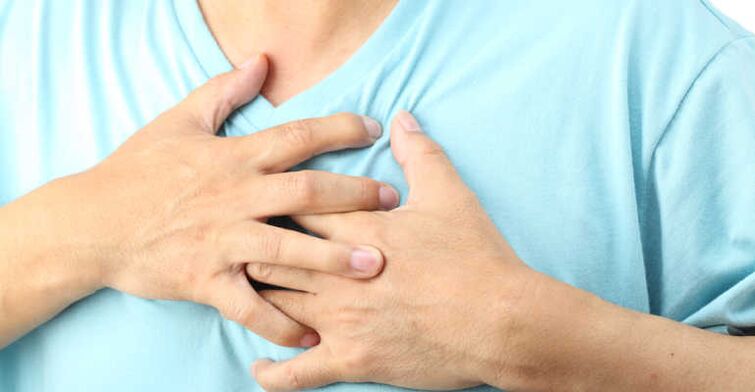
Many people over the age of 45 begin to feel pain in the heart area. This symptom puts a person in a state of panic, because it is not known what exactly caused this condition.
I often have thoughts that serious heart problems have started and that I may need urgent help from a cardiologist. Having made a cardiogram and received a completely satisfactory result, the person's confusion only increases.
What can cause heart pain? And most importantly, what to do in such a situation? The answer is actually simple, although not everyone knows the answer. Heart pain often occurs due to other diseases. This situation occurs especially in thoracic osteochondrosis. Is pain of this nature worth paying attention to?
How does osteochondrosis appear?
The mechanism is quite simple. During life, a person performs a certain physical activity. Most "lie" on the spine. To make it easier for the vertebrae to cope with the tasks assigned to them, there are intervertebral discs between them. The latter, in turn, act as shock absorbers, preventing the vertebrae from rubbing against each other.
Intervertebral discs tend to wear out. The main reason is too intense stress on the spinal column. Poor nutrition of cartilage tissue can also cause their gradual destruction.
Microcracks appear on the surface of the cartilage, tissues are destroyed, and as a result of this process, the vertebrae begin to touch each other. As a result of friction, an inflammatory process occurs, which is quite painful.
In thoracic osteochondrosis, there is active abrasion of the intervertebral discs in the thoracic spine. As a result of the pathology, the patient not only loses endurance, but is no longer able to perform physical activity in the same quantities. He begins to suffer from pain, which becomes more and more intense each time.
Specialized treatment is required to alleviate the patient's condition. If the therapeutic course is not completed on time, the patient may have a number of health problems. In particular, various pathologies of the cardiac system may appear.
Main symptoms of osteochondrosis
There are certain signs that will help to recognize thoracic osteochondrosis against the background of other diseases.
- First of all, it is worth understanding where exactly the source of pain is. In case of thoracic osteochondrosis, the pain mainly comes from the chest. It can be sharp, as if squeezing from all sides. Often there is a feeling of difficulty breathing, and even difficulty breathing with a cough. Sometimes the pain radiates to the area of the shoulder blades, where there is a feeling of dull pain. Unpleasant pain can "wind up" after physical exercise, and it can also be felt after sitting in an uncomfortable position;
- Sometimes thoracic osteochondrosis can appear in the form of numbness in the arms, legs, shoulders and neck. Often the limbs freeze even in summer, when there is no reason for it;
- Headache and dizziness occasionally occur.
These are the main signs of thoracic osteochondrosis that you need to pay attention to. All these painful conditions are the result of compression of blood vessels between the affected vertebrae due to thoracic osteochondrosis. It is believed that all these symptoms are more pronounced in women.
In addition to these three symptoms, which are considered the main ones, it makes sense to pay attention to the dorsalgia that occurs.This is a mild pain syndrome that occurs in the area of damaged vertebrae.
These pains are not intense, sometimes causing a feeling of muscle stiffness. In this case, there is a feeling that the source of the pain is in the stomach, liver or pancreas. In fact, this is a false feeling. Thoracic osteochondrosis has nothing to do with the digestive organs.
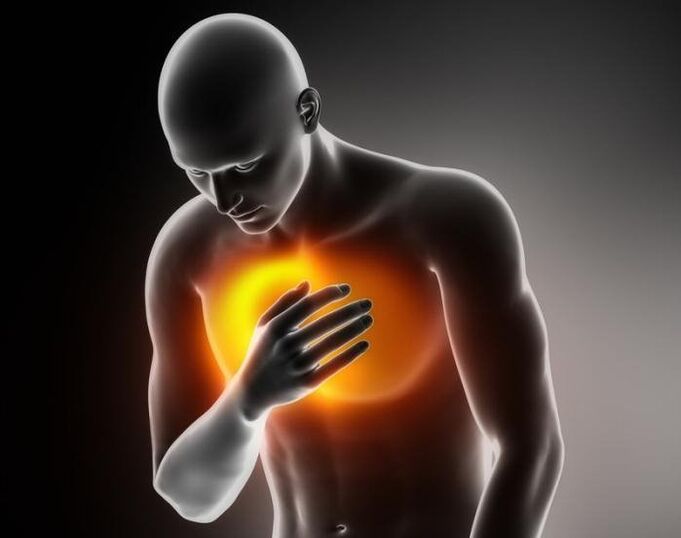
Sometimes thoracic osteochondrosis develops in parallel with the cervical form. Then it is quite possible to feel a lump in the throat, especially after physical activity.
What are the differences between osteochondrosis and heart pain?
How to distinguish thoracic osteochondrosis from heart disease, if the symptoms are very similar in many respects? There are a number of signs that you should pay special attention to.
Nature of pain
First of all, you must try to analyze the nature of the pain. Many heart diseases also begin with discomfort in the heart area. In osteochondrosis, the pain is compressive.
At the same time, it either grows or recedes, but most often it does not let go for a long time and is stable. The pulse often increases, which is even more deceiving. Sometimes there is a feeling of warmth inside the sternum.
With cervicothoracic osteochondrosis, the patient often complains of pain in the lower cervical vertebrae. Sometimes the weakness of the muscles of the left hand is noticed, especially the use of the little finger is problematic. Hand movements do not bring relief, they only increase the pain.
Sometimes the painful sensation spreads to the left quadrant of the body, affecting not only the chest, but also the neck, left arm, and sometimes the face. This condition can last quite a long time, from several hours to several days.
Along with initial angina and heart attack, some pain sensations can be of a similar nature. The main difference is that in osteochondrosis the pain intensifies when you inhale. A venodilator tablet from the group of nitrates or vasodilators will relieve pain caused by heart problems. This method will not help in any way against osteochondrosis.
But when the anesthetic solution is injected into the area of VI, VII cervical vertebra and I thoracic vertebra, the pain disappears. If distilled water is given instead of anesthetic, a slight burning sensation occurs in the chest area. This is a clear sign that the cause of the pain was thoracic osteochondrosis.
Duration of pain
This sign also requires more careful consideration. If you have heart problems, the pain in its area does not last long, usually a few minutes. While the painful sensation caused by thoracic osteochondrosis can last for several days.
But there is a catch: if the pain does not go away for several days, and there is obvious weakness in the whole body, consult a doctor immediately.
It is quite possible that the cause of weakness is an acute myocardial infarction.
Location of pain
The location of the pain is equally important. In heart diseases, the source of pain is concentrated in the left side of the chest, sometimes the pain radiates to the neck, back of the head and shoulders. While in osteochondrosis, the pain syndrome affects the thoracic, lumbar and cervical part of the spine.
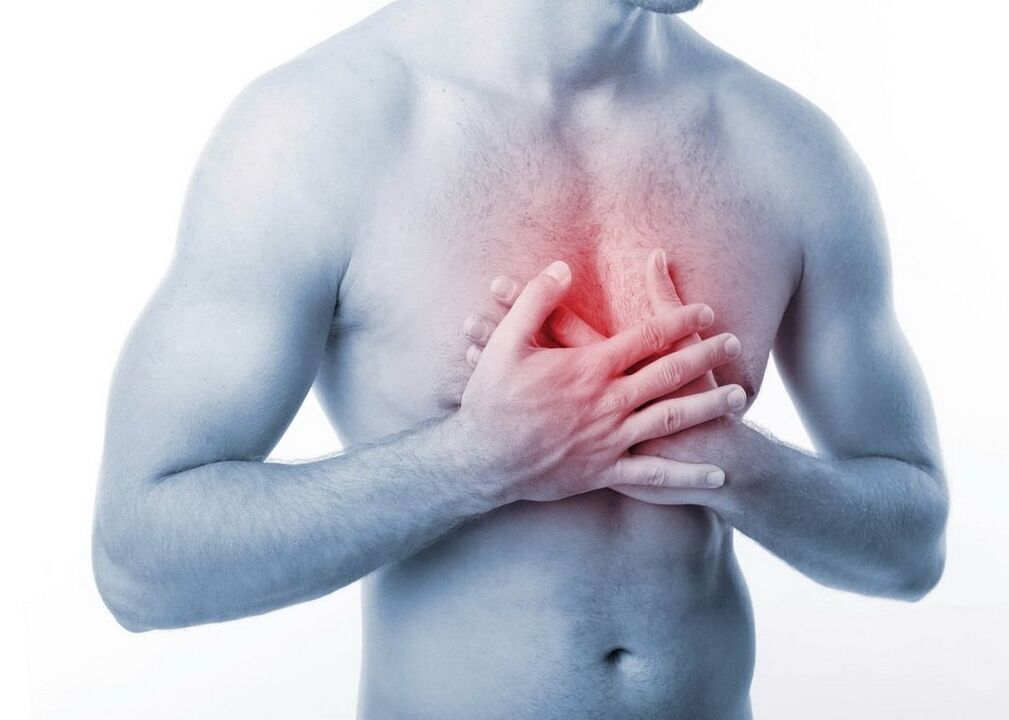
Associated symptoms
Pay attention to accompanying symptoms. In most cases, heart pain does not go away without increased heart rate and breathing. Sometimes neck veins can swell, for example, with pericarditis.
In osteochondrosis, such a symptom is not observed, but a general stiffness of movement may appear.
Why does tachycardia and arrhythmia occur in osteochondrosis?
Arrhythmia is perhaps the most common consequence of uncontrolled thoracic osteochondrosis. In this disease, there is often compression of the artery that runs along the entire spine.
Compression can be caused by bony growths and hypertonic muscles. As a result, the pressure inside the blood vessels increases. It takes more effort for the body to "push" the blood through the curve. Against the background of this phenomenon, the heart rate increases.
Arrhythmia can manifest itself in different ways. Alternatively, it can lead to sinus tachycardia. But how to find out what exactly caused tachycardia - heart disease or thoracic osteochondrosis?
- Tachycardia with spinal problems is a constant occurrence. The heart rate is approximately 90 per minute. It is observed even in a state of complete rest, while in diseases of the heart system, the heart rate increases with increased physical activity;
- Heart rate can increase when a person takes an uncomfortable position, especially if the spine is exposed to increased stress at this time;
- In osteochondrosis, tachycardia maintains a certain rhythm, the interval between contractions does not change, it is always the same;
- As soon as targeted treatment of osteochondrosis begins, tachycardia begins to disappear, the problem resolves itself.
If a symptom such as tachycardia is left unattended and timely treatment is not started, the heart muscle may not be able to withstand the increased load.
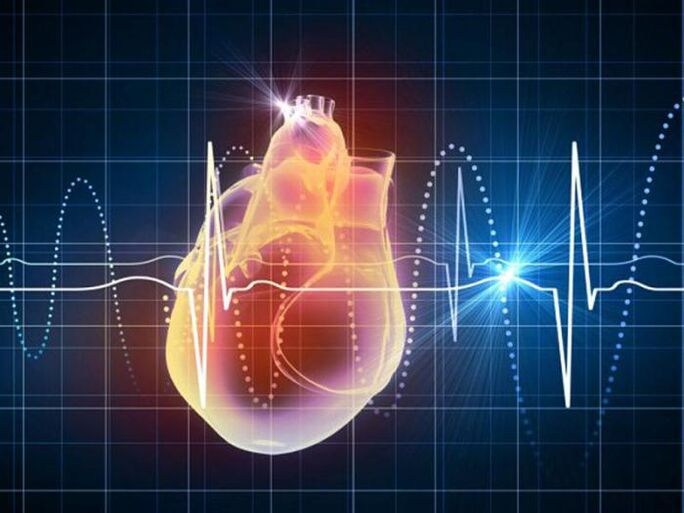
As a consequence of such neglect, extrasystole may develop.
Extrasystole due to thoracic osteochondrosis?
This disease can occur bypassing tachycardia. It occurs much less often than tachycardia and occurs in advanced forms of osteochondrosis. The disease is also a consequence of an abnormal heart rhythm. It is caused by a prematurely accelerated contraction of the heart muscle, which is immediately followed by a normal one.
The person may not feel bad at all. Sometimes you may feel as if your heart has stopped for a moment or, conversely, accelerated. In this case, a very weak pulse is observed. It may not be traceable at all.
If you do not pay attention to these symptoms in time, it is very likely that chronic myocardial hypoxia will develop - this is one of the most serious diseases characterized by insufficient saturation of the heart muscle with oxygen. And that is already burdened with more serious problems.
For example, insufficient oxygen supply to the brain, which will also lead to a series of serious disorders in the functioning of the central nervous system.
The first signs of extrasystole are observed only during physical activity. At rest, the heart rate returns to normal on its own. What signs can be used to determine the presence of extrasystole in osteochondrosis?
- Rapid heartbeat with a barely legible pulse;
- The muscles between the shoulder blades are constantly tense;
- A person often feels dizzy, weak and dizzy;
- There is often a feeling of increased heat, increased sweating;
- It does not release the feeling of inner discomfort;
- The increase in heart rate occurs periodically, it is unstable and works on the principle of waves - sometimes it increases, sometimes it almost dies out;
- Extrasystolic ejection volume exceeds the norm - this indicator can be determined using a tonometer.
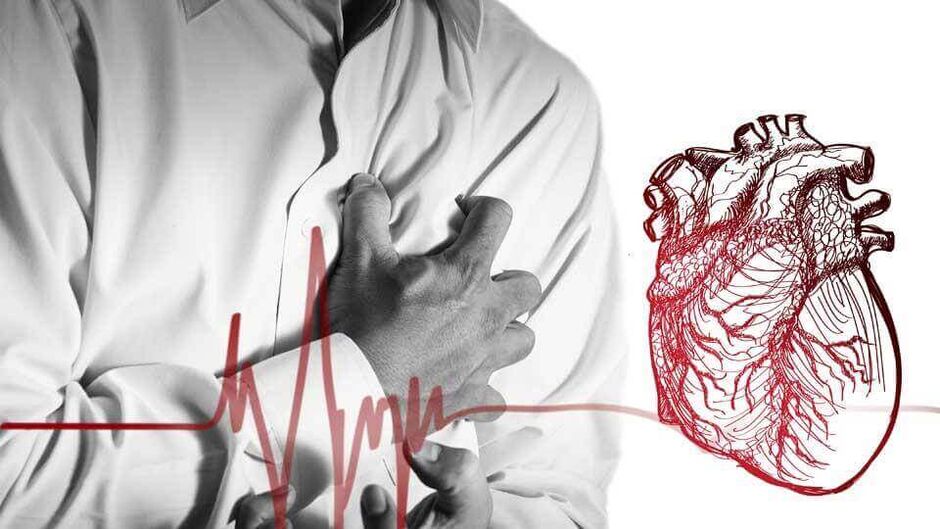
These symptoms can be felt all the time, but most often intensify at night or when the patient is in a horizontal position. Elementary movements of the limbs increase the symptoms.
This feeling can last for several hours. All attempts to stabilize the heart by taking cardiac drugs do not give a positive result. Attempting to determine the cause of heart disease through an EKG also does not answer the question.
If attempts to administer anesthetic between the VI and VII vertebrae of the cervical spine and the I vertebra of the thoracic spine gave a positive result, there is no doubt. The cause of heart problems in this case was precisely thoracic osteochondrosis.
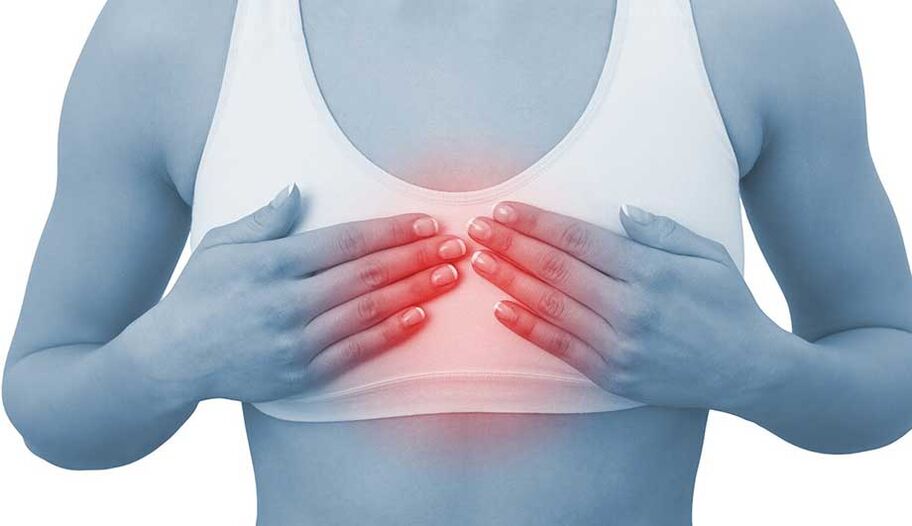
When trying to palpate the thoracic vertebrae, the pain in the heart also increases.
Hypertension as a consequence
Very often, thoracic osteochondrosis goes hand in hand with high blood pressure. The reason for this duet is compression of the vertebral artery. This can happen due to muscle spasm, resulting in significant swelling of the muscle tissue. The reason for the compression of the artery can also be the movement of the vertebrae - such a violation also occurs in thoracic osteochondrosis.
For the simple reason that the vertebral artery is responsible for supplying the brain with oxygen and other useful components, there is a lack of necessary substances for normal functioning. Brain cells are in a state of starvation.
In order to supply the brain with the appropriate amount of nutrition and "push" the blood flow through the bend, the body is forced to increase the speed of blood flow. In this mode of operation, the body begins to automatically release substances that help increase blood pressure.
This allows for proper nutrition of the brain, but leads to hypertension.
If you do not draw a parallel between osteochondrosis and high blood pressure and do not start treating hypertension as an independent phenomenon, it is unlikely that such treatment will give long-term sustainable results. Such experiments can only worsen the situation, adding additional problems in the functioning of the cardiovascular system.
How to determine hypertension caused by osteochondrosis?
- Periodically, the patient feels dizzy, most often in moments of overload;
- Frequent sleepiness, due to insufficient supply of oxygen to the brain, the body tries to "save" nutrients in order to keep the vital organs in working condition. The state of sleep helps to save energy;
- Constant weakness is also a consequence of the brain not receiving enough oxygen;
- Disorder, confusion;
- The appearance of "floating" in front of the eyes - this symptom is often noticed by people with high blood pressure, not knowing that the cause of this pressure is most likely not in the poor condition of blood vessels, but in osteochondrosis;
- Occasionally, all objects begin to see double;
- Vision often deteriorates, the reasons are the same - little oxygen;
- Hearing damage;
- With significant oxygen starvation, fainting may occur - this is a protective reaction of the body.

Diagnostics
Knowing the signs of the disease is good, but the most accurate diagnosis can only be made by a doctor using modern diagnostic tools. The simplest and most accessible way is the EKG. This study will allow us to quickly determine whether the cause of pain in the heart area is a malfunction of the cardiovascular system or whether this disease has some other pathology.
If the EKG confirms that the heart is working properly, it makes sense to prescribe an MRI. This method allows you to get a layer-by-layer image of the entire spine or parts of it. These images will allow you to quickly and accurately determine whether a person has problems with the spine.
If osteochondrosis is suspected, treatment should be started immediately.



































